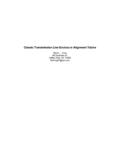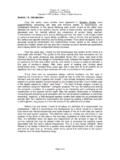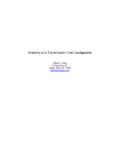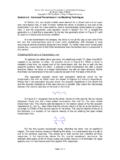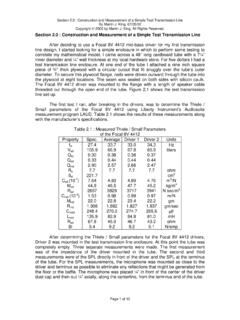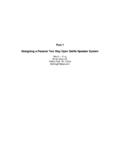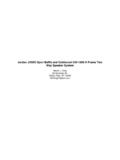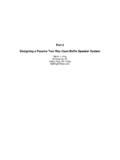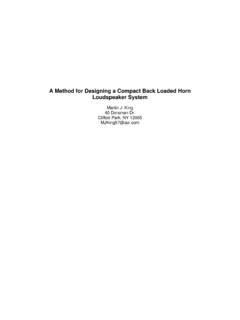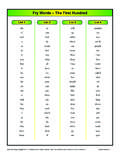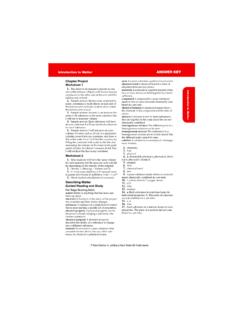Transcription of 6 Front Horn - Quarter Wave
1 Section : Design of a Front Loaded Exponential horn By Martin J. King, 7/01/08. Copyright 2008 by Martin J. King. All Rights Reserved. Section : Design of a Front Loaded Exponential horn For a couple of years, a Front loaded horn MathCad worksheet was available for downloading from my website. The worksheet was derived to simulate the Front loaded horn geometry shown in Figure The model solved the equivalent acoustic and electrical circuits as shown in Figures and respectively. A unit input of 1 watt into an assumed 8 ohm voice coil resistance, was applied as a constant voltage of volts RMS. There were minor updates to this worksheet over the years to extend the scope and correct a few minor bugs. At this point, a complete analysis of the equivalent circuits could be performed and the derivations would drag on for many pages. But this type of analysis, while providing some very useful sizing and limitation relationships, would probably not provide any intuitive feel for the workings of an exponential Front loaded horn speaker.
2 So instead of a rigorous mathematical derivation, which can be found in a number of other excellent technical references, the understanding gained in the preceding sections will be used to produce a set of simulations intended to characterize how a Front loaded exponential horn works and what trade-offs can be made to optimize the final system performance. In all of the following simulations, it was assumed that the cross-sectional areas are circular. Square and rectangular cross-sectional areas will have to be examined later in a separate study. Probably the most important results presented so far are the resistive nature of the acoustic impedance of the horn and the potential for a large increase in the volume velocity ratio above the lower cut-off frequency fc. This means that the Front of the driver is radiating into a pure acoustic resistance that is a function only of the air density, the speed of sound, and the horn throat area.
3 C Zthroat =. S0. Keeping this in mind, while looking again at Figure , we are left with a driver mounted in a closed box radiating into an acoustic resistance. Once the horn speaker system is recognized as being a driver in a closed box radiating into a pure acoustic resistance, the design problem can then be split into two separate sub-systems. Sizing the driver in a closed box as one sub-system and mating it to an appropriately sized exponential horn as a second sub-system will be the approach used in the following simulations. The two sub-systems are consistent if the same tuning frequency is used. A consistent design mates a driver in a closed box with an exponential horn geometry where both have the same tuning frequencies. This last statement is an important definition that will be assumed throughout the remainder of this document.
4 The resulting motion of the driver's cone, the driver's volume velocity, is amplified by the horn to become an even greater volume velocity at the horn 's mouth. This result produces a dramatic increase in speaker efficiency compared to a closed or ported box. Looking back at Figures through , there is no evidence of strong resonances in a correctly sized horn which would be seen as peaks in the magnitude response and rapid Page 1 of 26. Section : Design of a Front Loaded Exponential horn By Martin J. King, 7/01/08. Copyright 2008 by Martin J. King. All Rights Reserved. phase shifts. All of this depends on the horn being sized to act as a horn and not as a resonant transmission line which was demonstrated in Figures through Figure : Front Loaded horn Geometry Back Chamber Front Chamber horn S0B SDB SDF SLF. S0 = Sthroat SL = Smouth Lhorn LF.
5 LB. where : horn Geometry is defined by : S0 = Sthroat = throat area SL = Smouth = mouth area Lhorn = horn length Front Chamber Geometry is defined by : SDF = Front chamber area at the driver end SLF = Front chamber area at the throat end LF = Front chamber length Back Chamber Geometry is defined by : SDB = back chamber area at the driver end S0B = back chamber area at the closed end LB = back chamber length Page 2 of 26. Section : Design of a Front Loaded Exponential horn By Martin J. King, 7/01/08. Copyright 2008 by Martin J. King. All Rights Reserved. Figure : Acoustic Equivalent Circuit for a Front Loaded horn Speaker Zab Ratd Mad Cad Ud pg Zal p where : pg = pressure source = (eg Bl) / (Sd Re). Rad = driver acoustic resistance = (Bl2 / Sd2) [Qed / ((Rg + Re) Qmd)]. Ratd = total acoustic resistance = Rad + (Bl)2 / [Sd2 ((Rg + Re) + j Lvc)].
6 Cad = driver acoustic compliance = Vd / ( air c2). Mad = driver acoustic mass = (fd2 Cad)-1. Zab = back chamber acoustic impedance Zal = horn acoustic impedance (including Front chamber). Ud = driver volume velocity = Sd ud ud = driver cone velocity then : UL = mouth air volume velocity = Ud = UL / Ud = volume velocity ratio uL = mouth air velocity = ud = uL / ud = velocity ratio Page 3 of 26. Section : Design of a Front Loaded Exponential horn By Martin J. King, 7/01/08. Copyright 2008 by Martin J. King. All Rights Reserved. Figure : Electrical Equivalent Circuit for a Front Loaded horn Speaker Rg + Re Lvc eg ed Lced Cmed Red Zeb Zel where : eg = voltage source = volt Rg+Re = electrical resistance of the amplifier, cables, and voice coil Lvc = voice coil inductance Lced = inductance due to the driver suspension compliance = [Cad (Bl)2] / Sd2.
7 Cmed = capacitance due to the driver mass = (Mad Sd2) / (Bl)2. Red = resistance due to the driver suspension damping = Re (Qmd / Qed). Zel = horn equivalent electrical impedance (including Front chamber). = (Bl)2 / (Sd2 Zal). Zeb = back chamber equivalent electrical impedance = (Bl)2 / (Sd2 Zal). ed = Bl ud Page 4 of 26. Section : Design of a Front Loaded Exponential horn By Martin J. King, 7/01/08. Copyright 2008 by Martin J. King. All Rights Reserved. The Generic Driver : Before any simulations can be run, a generic driver needs to be defined that is easily adjustable to different combinations of Thiele / Small(8,9,10,11) parameters. The following driver parameters have been defined and are intended to represent a typical eight inch diameter full range driver such as those produced by Lowther, Fostex, or AER. All of the results that follow are really intended for full range driver applications but should also be applicable to larger woofer or mid-bass drivers.
8 The generic full range driver is defined below based on key input properties and some derived properties. When looking at the relationships used to calculate the derived properties, please keep in mind that MathCad internally automatically converts frequency in Hertz to frequency in rad/sec. This property of MathCad leads to equations that may not look exactly like those familiar to the speaker designer. In equations containing a frequency term, a 2 multiplier may be missing or added depending on the desired units of the result. Driver Thiele / Small Parameters : Generic Driver Derivation fd := 50 Hz Qmd := 4. Re := 8 ohm Qtd := Lvc := 0 mH M md := 14 gm 2. Sd := 205 cm Derived Thiele / Small Parameters 1. Qed := . 1 1. Qed = Qtd Qmd . 1. Cmd := M md fd 2 4 m Cmd = 10. newton Vad := Cmd c Sd 2 2 . Vad = 1. o := Vad 2 c Qed fd 3 3 . o = SPL := 112 + 10 log o ( ) SPL = dB.
9 Fd Re Mmd newton Bl := Bl = Qed amp Now that a generic driver has been defined, baseline horn geometry can be formulated and a simulation run to calculate the on axis anechoic SPL response, the electrical impedance, and the impulse pressure response. Modifications can be made to Page 5 of 26. Section : Design of a Front Loaded Exponential horn By Martin J. King, 7/01/08. Copyright 2008 by Martin J. King. All Rights Reserved. the generic driver, and the exponential horn geometry, to study the changes that occur in the calculated responses. Baseline Exponential horn Design : The first simulation to be run, and the results presented, will be referred to as the baseline design. The lower cut-off frequency fc is specified as 150 Hz. A Front chamber will not be included in the baseline horn geometry. The throat area is set equal to the driver's Sd so that a length can be calculated.
10 This style of horn system can be readily found on the Internet crossed over to bass enclosures yielding a complete full range speaker system. To start the design process, the area of the horn mouth is calculated using Equation ( ). Smouth = (1 / ) x (c / (2 x fc))2. Smouth = (1 / ) x (342 m/sec / (2 x 150 Hz))2. Smouth = m2 = in2. Smouth = x Sd Using Equation ( ), the flare constant is calculated next. m = (4 fc) / c m = (4 150 Hz) / 342 m/sec m = m-1. And finally, the horn 's length is calculated using Equation ( ) after setting the throat area equal to Sd. Lhorn = ln(Smouth / Sthroat) / m Lhorn = ln( / 1) / m-1. Lhorn = m = in The horn sub-system geometry is now completely defined. To define the back chamber, a consistent approach is used by tuning the driver mounted in the back chamber to the same 150 Hz cut off frequency. Sizing of the horn geometry and the driver mounted in a sealed box are consistent since the same tuning frequencies are selected.
